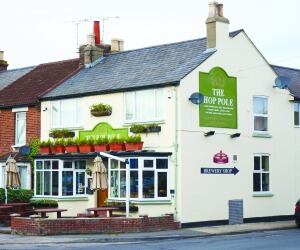I reported in December that I had cut the ribbon at the opening of the brewhouse, which marked a return to brewing invBuckinghamshire’s main town after a gap of 75 years.
The Aylesbury Brewhouse and the Hop Pole pub are owned by Vale Brewery in Brill.
Vale’s original brewing kit has been installed in the pub, where Smith and Renton are given a free hand to develop one-off brews.
When Vale’s manager Ian Mackey asked if I would like the brewhouse to make a beer to a style of my liking, I thought for half a nano-second and said “IPA”.
I’m bewitched by the history of India Pale Ale, which — as the first pale beer made anywhere in the world in the 19th century — changed the course of brewing history.
Smith and Renton found a Victorian recipe for IPA that was so high in alcohol and heavy with hops that it would have rendered the good people of Aylesbury both legless and incapable of speech.
So we reduced this to a more manageable modern version, but at 7% it will still be strong, and its 80 units of bitterness mean it is twice as bitter as most premium beers.
We underscored the traditional nature of the beer by plumping for all-English ingredients: Maris Otter malting barley and Fuggles and Goldings hops.
To make seven barrels of beer, Smith and Renton used 13 bags of malt, each containing 25kg of grain. I stood to one side, stressing my old war-wound and dodgy back, while they heaved the grain into a hopper, where it was fed to the mash tun standing alongside.
By 7.45am all the grain had been transferred to the tun, where it was thoroughly mixed with water at a temperature of 74°C. The brewers ‘Burtonised’ the water: this means adding such mineral salts as gypsum and magnesium to reproduce the salty waters of Burton-on-Trent, the historic home of IPA in the 19th century.
The mash would stay in the tun for 90 minutes, while the temperature fell to 65.5°C and enzymes in the malt began to convert starch into fermentable sugar.

We stopped for brewers’ breakfast. The staff of the Hop Pole provided a gargantuan fry-up with lashings of hot tea to keep us fully operational for the rest of the day. At 9am we returned to the brewhouse to prepare for the run-off — the transfer of the sugary extract, known as wort, from the mash tun to the copper.
The spacious room, with its wood-jacketed brewing vessels, was filled with the inviting aroma of fresh, warm bread — the result of the creation of malt sugar in the mash tun.
Smith and Renton turned a tap at the base of the tun and the aroma of fresh bread intensified as the wort flowed into a receiving vessel called the underback, where it’s transferred to the copper for the boil with hops.
Rotating arms in the roof of the mash tun revolved, sprinkling the thick bed of grain with more hot water to flush out any remaining sugar.
By 10.15am, the run-off was finished and the wort frothed as it poured into the copper. It was time for the worst part of brewing — digging the spent grain from the mash tun.
With my war-wound really giving me gyp by this time, I allowed the brewers to bend their backs and fill sacks with the warm grain, which will go local farms as cattle feed.
At 11.10am the first batch of hops — a 50:50 blend of Fuggles and Goldings — were poured into the top of the copper. The warm bread aroma now blended with the herbal, piny, resinous character of the hops.
More hops would be added five minutes before the end of the boil, with further additions in the fermenting vessels and in the casks where the beer will mature.
The boil lasted for 85 minutes. The hopped wort stood for 10 minutes and was then re-circulated in the copper on the bed of hops to pick up maximum aroma.
The piping-hot liquid passed through a heat- exchange unit, which lowered the temperature in preparation for fermentation. Fifty minutes later, the hopped wort, with a temperature of 21°C, reached the fermenters, where it was vigorously mixed with yeast.
Now nature would run its course. Fermentation would last for seven days and the beer will then be stored for three months: we deliberately chose that period to replicate the traditional journey of a cask of Victorian IPA from England to India by fast clipper.
Towards the end of May, my IPA — working title Sink or Swim — will be ready for tasting. The brewing day ended at 5.45pm and my most urgent need was a kip.
